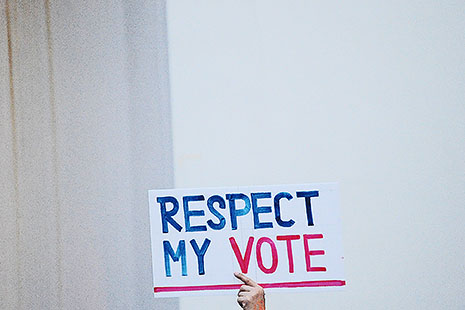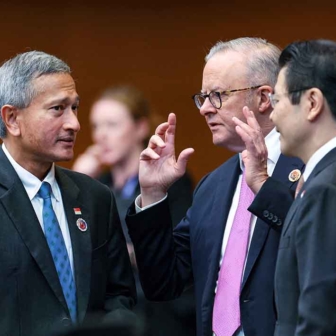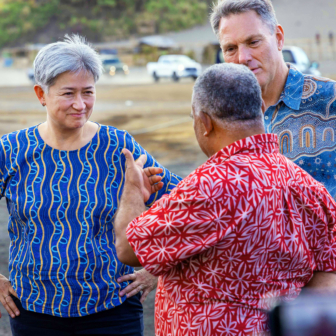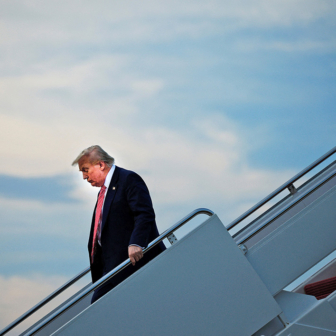Thailand has been in crisis since an armed forces coup overthrew prime minister Thaksin Shinawatra in September 2006, ultimately forcing him into exile. Although his opponents used fair means and foul to keep various incarnations of Thaksin’s party out of power, his sister Yingluck Shinawatra became Thailand’s first female prime minister following a resounding electoral victory for Thaksin’s Pheu Thai (For Thai) party in 2011.
But Yingluck’s government started to unravel in 2013 when it attempted a mass amnesty for those charged with corruption or other crimes. It was clear the amnesty was designed to allow Thaksin to return from exile. Opposition to the government surged, further fuelled by the failure of a populist rice-subsidy scheme that not only provided opportunities for corruption but also proved so costly that the government couldn’t honour its payments. Yingluck faces corruption charges over the scheme.
On 7 May, the Constitutional Court removed Yingluck from office for her role in trying to install the brother of Thaksin’s former wife as police chief. She pleaded, disingenuously, that he was no longer family. The divorce was a political convenience, of course, and Yingluck’s manoeuvre shows just how ingrained oligarchic politics is in Thailand.
In the end, the evolving crisis led to another coup on 22 May. Intriguingly, it has met with much less opposition than anyone expected.
To understand the crisis in Thai politics, it’s important to examine the momentous changes Thai society has undergone in recent decades. If certain key institutions, such as the monarchy, have not yet been transformed, then they are about to be. Old relationships have been destabilised; new ones are not yet in place. It is this setting – the perfect opening for a populist demagogue like Thaksin – that explains much more about contemporary Thailand than the grossly simplified image of a struggle between the “rural poor” and the urban middle class and elites.
I have been watching events unfold from neighbouring Laos, a perfect observation point. Thailand’s northeast region, just across the border, accounts for 31 per cent of the total population. Commonly called Isan (and its people, Khon Isan), the region is mostly ethnic Lao, and has been a major base of support for Thaksin. According to anthropologist Charles Keyes, the region’s ethno-regional identity and solidarity has made the local people into a formidable political force. But, as Keyes also shows, Isan has been transformed out of sight since he first visited fifty years ago.
When Keyes and his wife Jane went to central Isan in 1963–64 it was still the poorest region in Thailand. Self-sufficient peasants battled with irregular rainfall and poor soils to make ends meet. The local geography conspired against commercial agriculture, and so men had begun heading to Bangkok for work in construction or other menial jobs, especially during the dry season. When Thailand became a playground for US troops on leave from the war in Vietnam, women headed to the urban bars and brothels for work. American aid drove roads through the region and sped up the circulation of people between city and countryside. Drawn out of their rural isolation, the migrants came into contact with others like themselves from across Isan, fomenting an ethno-regional sentiment. Together, they became aware of the wealth differences between Isan and Bangkok.
For residents of Bangkok, many of whom were of Sino-Thai descent, these dark, short-statured people in simple clothing were ban nok, “country bumpkins” whose dialect was crude to their ears. When TV came along they became the fall guys in Thai comedies, and in everyday life they had to suffer the contempt of those above them.
Keyes describes how the people of this region became Thai through an expansion of the national bureaucracy, the centralising of the Buddhist sangha, and especially – since the 1930s – schools that educated both boys and girls. They learned to use the central Thai language and its various polite forms and, especially from the 1950s on, they learned to love the Thai king, Bhumibol Adulyadej. Essentially, it was good old-fashioned nation building, and similar processes occurred for every region, including Bangkok, where the Chinese, for instance, needed to be turned into Thais.
Migration in search of work, especially overseas, transformed the lives of Isan’s peasants to the point where they became rural entrepreneurs. “By the early twenty-first century,” writes Keyes, “non-agricultural work had become the most significant source of cash income for villagers. The money villagers brought back from urban or overseas work was increasingly invested not in agriculture but in small enterprises such as convenience stores, repair shops, and food stalls as well as rice mills.” Importantly, it was also used to pay for higher education for children, of whom there were fewer now that women were embracing birth control.
Thaksin’s power base is in the north, around Chiang Mai, where the conditions suited full-scale commercial farming. This, too, caused migration from the countryside to the city and upward mobility through education. The north’s ethno-regional identity is strong – they are known as Khon Muang – but because their aristocracy had been seamlessly absorbed by the Siamese state they are not looked down on like the people of Isan. Indeed, Thai soap operas are more likely to romanticise old northern aristocratic life and emulate its speech forms.
In one sense, what had been forming in the Thai countryside by the time of Thaksin’s rise in the late 1990s was a rural entrepreneurial class determined to better their lives and sweep away any bureaucratic obstacles. Thaksin the mega-entrepreneur played to this audience perfectly, and his million-baht-per-village loan scheme, alongside cheap universal healthcare, won him unwavering support. The majority of pro-Thaksin activists in the Red Shirt movement are in their forties or older – exactly the group that has made the transition from scarcity to having tasted the good life. Big, shiny cars are now ubiquitous on Isan’s highways; as one Red Shirt follower said, “We are not going back to riding motorcycles.”
This doesn’t quite fit with journalistic clichés about the “rural poor.” In the same way, bland assertions about the “Bangkok middle class” blur the changing urban landscape.
As its skyline shows, Bangkok has been remade since 1980 by dramatic economic growth. The city’s workforce has diversified and middle-class occupations have grown steeply. Labour shed by agriculture has flowed into manufacturing, where the workforce grew from 14 per cent of the total in 1990 to 20 per cent in 2008. But white-collar work grew even faster – from one-in-five employees to almost one-in-three – and within its ranks professionals and senior white-collar workers grew fastest.
Even in Keyes’s rural village, 17 per cent of children in 2005 had gone on from high school to vocational colleges or (in 4 per cent of cases) to university, and 22 per cent had finished high school. Because most of them sought white-collar jobs, often in the capital, migrants played an important role in the growth of the middle class in Bangkok. Many are upwardly mobile, socially and culturally, and have learned to speak flawless central Thai. They dress for and aspire to an affluent urban lifestyle. An important indicator of the dislocations involved in cultural change, however, is the fact that the Bangkok metropolitan area has one of the highest non-marriage rates for women in their twenties and thirties of any city in Southeast Asia.
For these upwardly mobile new members of the middle class, the plebeian style adopted by the Red Shirts is exactly what they are running away from. Of course, many of them aren’t politically active, but others have joined the anti-Thaksin forces because they agree with the middle-class critique of the government corruption epitomised by the Thaksin years. No doubt these migrants are part of the reason why the Thai press speaks of bitter divisions in families over politics.
Over this same period, Thailand’s elite has also changed radically. The Asian financial crisis of 1997 hit Thailand especially hard, sending many old business families to the wall. The boom years had been built on major inflows of foreign investment and a globalised economy. Close relations with the Thai state had once provided local capitalists with very comfortable incomes, but now globalisation had destabilised the cosy arrangements. In fact, Thaksin’s wealth in the telecommunications sector had initially been built on a deal that gave him a monopoly. Yet he was part of a new breed of Thai capitalists who thought globally and aimed to take over the government and run the state as if it were a business. As Pasuk Phongpaichit and Chris Baker write in their superb biography, “Thaksin’s project was built around a fatal confusion – between business and politics, country and company, Shin Corp and Thailand. Throughout his career, politics and profit-making were entwined around one another like a pair of copulating snakes.” After the election of his Thai Rak Thai (Thai Love Thai) party in January 2001, Thaksin’s already rich business and family network went into a feeding frenzy.
The monarchy, headed by enigmatic King Bhumibol Adulyadej, is also about to change irreversibly. A conservative who believes in rule by righteous individuals, the king has done deals with military dictators to strengthen the monarchy but has never been a thug himself. His preference, as much as one can discern it, is for a form of guided democracy. He has been an enormously popular and respected figure for many decades. But he became physically enfeebled just as the political turmoil began, and the Queen has since been crippled by a stroke, and so now the royal couple are marionettes of the Privy Council.
The heir, Crown Prince Vajiralongkorn, has none of his father’s political talent or charisma. He is believed to have had dealings with Thaksin, although it is unclear what these amount to. In late November last year, according to the Economist, “the King signed a decree mandating that all decisions by the powerful defence council were subject to veto by the Crown Prince,” but whether Vajiralongkorn really wields this power is moot. With the passing of King Bhumibol, the personalised networks that have been spun around him for so long will unravel and Vajiralongkorn will find himself presiding over a weakened monarchy. It will be a big blow for conservatives.
For many Thais the monarchy evokes a stable social hierarchy in an increasingly unpredictable world. But as society diverges from this ideal a kind of reactionary nostalgia has gripped many people – as can be seen in the Yellow Shirt movement. In reality, the social changes have led to seismic shifts in how people perceive their relationship to authority. Thailand has been transformed into a commercialised society of strangers – entrepreneurial farmers in the countryside, workers flocking into the factories and dormitory suburbs, the nouveaux riches flaunting their wealth in city night clubs – and all these people, millions upon millions of them, can’t be slotted into the old framework. They had no intention of breaking the old status system down; they were just seizing whatever opportunity for betterment the new Thailand offered. But break down the old system they did. All across the social spectrum demands for equality are heard.
Thaksin’s fatal mistake was to alienate the old military elite, which saw him as challenging the moral and political authority of the now visibly ageing king. There is little doubt that the 2006 coup was masterminded by the head of the Privy Council, retired general Prem Tinsulanond. But he and the other generals, unlike old coup-makers who had to deal only with a sea of peasants and a state-centred economic system they were capable of running, now found that Thailand’s modern economy and society had grown too complex for them. They failed not only the democracy test, but also the task of managing the economy and society. It was a sobering lesson for the armed forces, and perhaps General Prayuth Chan-ocha, the leader of the latest coup, has learned from their mistakes.
After the 2006 coup the block of old capitalists, at the centre of which was the now enormously wealthy Crown Property Bureau, was joined by businessmen alienated by Thaksin’s winner-takes-all style, along with the armed forces and many in the middle class, to form the core of the forces arraigned against Thaksin. Some capitalists who had joined the Thaksin bandwagon found themselves frozen out of contracts, and by the time of his ouster considerable disgruntlement had emerged in his camp. Had the coup not happened, Thai Rak Thai may have come apart at the seams.
The coup-makers faced a population that no longer buckled before a show of force. The Red Shirts – more formally the United Front for Democracy Against Dictatorship, or UDD – formed immediately after the coup. They organised anti-government rallies against the military government’s rule in 2006–07 and opposed the military’s 2007 constitution. After the Democratic Party’s Abhisit Vejjajiva was installed as prime minister, the UDD led major anti-government rallies in April 2009 and March–May 2010, resulting in violent clashes with military forces and casualties on all sides. They responded with arson in the capital and against government buildings in rural Thailand. I happened to be in Bangkok at the time, and travelling through streets littered with abandoned barricades of smouldering tyres and burnt-out shops and malls was eerie. No one wishes to see a repeat of it.
What has been out of focus in the discussion about democracy in Thailand, however, is the “liberal” part of the liberal-democratic equation. In many respects, nineteenth-century liberal fears of majoritarian rule seem to have come true. A “people’s constitution” of 1997 had strengthened liberal institutions by increasing the powers of the National Counter Corruption Commission, or NCCC, and by creating the first ever Constitutional Court. Accused of concealing assets by the NCCC, Thaksin quickly revealed that he had few liberal sympathies. “It’s strange that the leader who was voted in by eleven million people had to bow to the ruling of the NCCC and the verdict of the Constitutional Court,” he opined in August 2001, “two organisations composed of only appointed commissioners and judges, whom people do not have a chance to choose.”
The extrajudicial killings that followed Thaksin’s crackdown on drug crime, and the violent suppression of southern Muslim separatists that set off an unabated insurgency, illustrated his knee-jerk authoritarianism. In his more considered moments, Thaksin favoured the creation of a dominant-party state, like that of the People’s Action Party in Singapore. He was seeking power for the rest of his life.
Followers of the Red Shirts appear to have little comprehension, or perhaps sympathy, for liberal checks and balances. They simply insist that a majority at the ballot box gives the elected government unrestricted powers. It is a winner-take-all mentality that their leaders have encouraged.
Liberal institutions have also been undermined by opponents of Thaksin. First, the 2006 coup-makers, and then the appointed government led by the Democratic Party, manipulated these institutions to disband Thai Rak Thai (which, after one incarnation, re-emerged as Pheu Thai), and disqualified many of its politicians for five years. Suggestions by Yellow Shirt leaders that leading judges are beholden to the king rather than the constitution are plainly illiberal. Moreover, an alarming number of intellectuals have articulated reactionary, elitist solutions to the crisis that would disenfranchise Thaksin’s supporters, using the canard that their votes have been bought and accusing them of being ignorant peasants.
One final problem is the oligarchic nature of Thai politics. Political parties are the creatures of their rich owners. So Pheu Thai belongs to Thaksin and is run largely by him and his family. The aim in holding political power is to enhance one’s wealth and pork-barrel handouts for the party’s followers. The oldest party, the Democratic Party, is the closest Thailand has to a modern political party, but its conservatism and its failure to reach out to people in the north and northeast have crippled it electorally. This failure of the party system is crucial for understanding the current impasse. It would be a major step forward for democracy if the Red Shirts abandoned Pheu Thai and established a popular political party with a genuine political platform.
Not only have rural people “found their voices,” in Keyes’s words, but Thai society itself is now a cacophony of voices. It is a complex modern society that is a far cry from a world of stable hierarchies and benevolent kings. Does a royalist conservative like General Prayuth understand this? The junta’s propaganda about restoring social harmony and galvanising everyone to work for the nation suggest that older dreams live on. Yet Prayuth has so far been realistic and pragmatic. One of his first deft moves was to see that farmers shortchanged by Yingluck’s rice scheme were paid. He appears to understand that soldiers are ill-equipped to run a modern economy and society and is gathering experts around him to formulate policy and political reform. Indeed, his realism may produce surprises – for example, by decentralising power and reforming the party system.
But if he tries to permanently curtail the political rights of the people of Isan or the north, he can be sure of an even bigger crisis in the future. •




